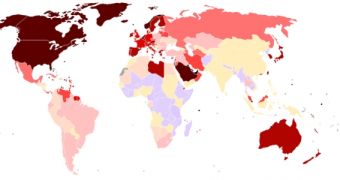The massive oil deposits in Canada, totaling some 173 billion barrels of sandy oil, are set to produce enormous amounts of greenhouse gases (GHG), which are to be released into the atmosphere if carbon traps are not set in place to capture and store carbon dioxide. Usually, these devices compact CO2, which is then placed in underground permanent storage.
Upgraders, machines used in sandy oil processing, which turn tar-like bitumen into synthetic refinery-grade crude, need to be retrofitted with such capturing devices, if Canada is to avoid making a mess of its environment in a few years. Already, huge poisonous lakes are beginning to appear in the Alberta region, where the deposits are concentrated, some so big that they can be seen from satellites on orbit.
"Only a small percentage of emitted CO2 is 'capturable' since most emissions aren't pure enough. Only limited near-term opportunities exist in the oil sands and they largely relate to the upgrader facilities," said the statement, which was posted on the CBC website, after the Canadian Broadcasting Corp got a hold of a copy, under the Freedom of Information Act.
Greenpeace climate and energy coordinator, Dave Martin, said that both the local and the federal governments will have a difficult task ahead, as "This is technology that will require massive subsidies," which authorities could deem as too high. "This is a boondoggle of the first order," he added.
"It's well known that there are some challenges in capturing emissions at oil sands facilities. But what our own analysis tells us is still up to 75 percent of oil sands [emissions] are capturable," argues Alberta's Energy Department spokesman, Jason Chance. The state already invested more than C$2 billion in oil sand upgraders and polluting power plants, in an effort to slow down the rate at which the industry is spilling carbon dioxide into the atmosphere.

 14 DAY TRIAL //
14 DAY TRIAL //